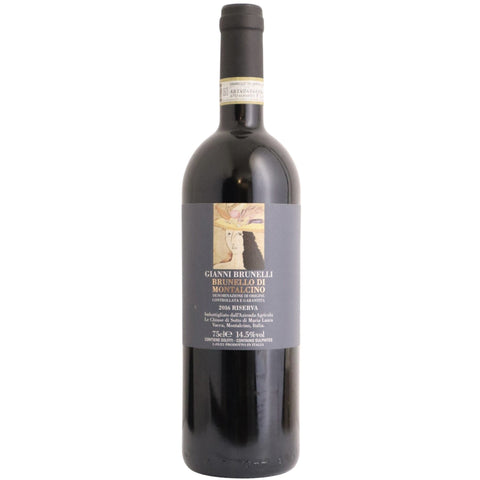
2016 Gianni Brunelli Brunello di Montalcino Riserva, Tuscany, Italy
Created by the blend of a careful selection of their 4 crus. Shows the best qualities of Sangiovese, with complex evolution of bouquet, succulent acidity and silky tannins. Combines finesse and body, structure and elegance.
ABOUT THIS WINE
100% Sangiovese sourced from Podernovone vineyard at an altitude of 500 meters with south-western exposure, planted in 1998, and Canalicchio vineyard at an altitude of 250 meters with north-western exposure, planted in 1989. The vines are grown in \galestro, clay loam soils at 350m. 30-day maceration followed by 30 months of aging in 25HL oak casks. Aged additional 6 months in 30HL oak casks. 2,300 bottles produced.
ABOUT THIS PRODUCER
Gianni Brunelli, a man of many interests, established Siena’s Osteria Le Logge (now one of the top restaurants of the city) in 1977. In 1987, he returned to Montalcino and purchased ‘Le Chiuse di Sotto,’ an estate that had belonged to his father Dino, with 2 hectares of vineyards standing at 250 meters above sea level in the northern part of the region. Brunelli replanted most of the vines in 1989, but left untouched a small plot of older holdings dating back to his father’s original 1947 plantings. After Gianni passed away in 2008, his wife Laura, who was already working at the estate, took the reins, along with her brother, Adriano.
A few years ago, the estate expanded with the purchase of the ‘Podernovone’ vineyard, located further south in Montalcino. The 4 hectare property sits at 500 meters above sea level and has a magnificent view of Monte Amiata. Podernovone’s soil is comprised of calcareous-marl and schist, which reflects light and heat, leading to a warmer site. ‘Le Chiuse di Sotto,’ a 2 hectare plot, is cool and airy, bringing bright acidity to the blend. The Brunelli’s vineyard sites allow them to blend north and south to achieve great balance, no matter what the vintage brings.
According to Laura Brunelli, the estate has been farmed organically since the beginning. As an alternative to pesticides, they use the sexual confusion method. In late July, a green harvest is performed in order to leave 7-8 bunches per vine. The vineyards are worked manually throughout the growing cycle – each 1ha of vines requires over 400 hours of work. Selected yeasts are used for fermentation; malolactic occurs naturally.
Details:
| Grape(s) | Sangiovese |
| Farming | Organic |
